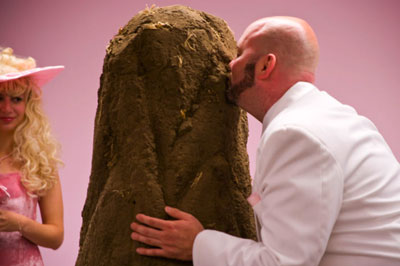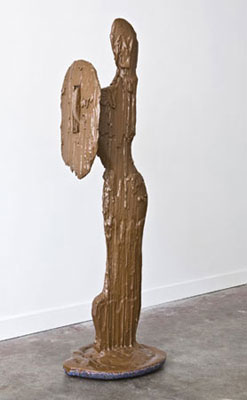The Underground Tour
by Matthew Offenbacher
I’ve heard that the Underground Tour, where you pay fourteen bucks for a peek at Pioneer Square’s subterranean ghost city, used to be better. It was longer, kitschier, more fun. You’d see fake skeletons and treasure chests along the debris-strewn storefronts. When I went last year, though, we spent most of the time above-ground, listening to an interminable introduction full of scatological jokes, performed by a chipper women sitting cross-legged on old Doc Maynard’s bar, just inside from where you buy the tickets. Apparently, during its formative years Seattle had a hard time dealing with the waste of its rapidly growing population. That our wastes now flow to the tune of 117 million gallons a day to a treatment plant out in Discovery Park is the realization of a long cherished dream. The undergrounding of human waste is a triumph of city engineering. We don’t want to see or smell it; it is a great benefit for public health that we don’t have contact with it. Freud argued somewhere that jokes about shit are funny because they let us enjoy our shit, like when we were children, if only for a moment. To enjoy our shit is to be momentarily free from civilization. Dominique Laporte summed this up in his 1978 book The History of Shit: “Surely, the state is the sewer.”
So, what is it with Seattle and sewers? Not only is one of our most popular tourist attractions organized around them, excrement and its disposal frequent our contemporary art. There is Susan Robb’s show at Lawrimore Project this month, where I’ve heard that Scott Lawrimore’s excrement will be used to generate the electricity that powers the rest of the installation. Jenny Heishman exhibited her drippy brown sculpture Mud Thing at Howard House this past fall. Steven Miller married an excrementally shaped human-sized pile of dirt on wheels a few years ago. Eric Elliot’s paintings are heavy with fetid paint. You can probably think of other examples. Alex Schweder is maybe our old master of this genre. He has built his career around integrating an interest in excrement with that other consuming Seattle passion, architecture. In his work, architecture stands-in for repressive authoritarian forces while body fluids promise liberation. In other words, the state represses shit; art redeems it.
But what’s the nature of this redemption? Excrement is a symbol of the individual and, in art, often stands in for the artist’s skill at extruding their inner life into an external, material thing. Slavoj Žižek, in his book On Belief, writes about this romantic idea:
The small child who gives his shit as a present is in a way giving the immediate equivalent of his Inner Self. Freud’s well known identification of excrement as the primordial form of gift, of an innermost object that the small child gives to its parents, is thus not as naive as it may appear: the often-overlooked point is that this piece of myself offered to the Other radically oscillates between the Sublime and – not the Ridiculous, but, precisely – the excremental. This is the reason why, for Lacan, one of the features which distinguishes man from animals is that, with humans, the disposal of shit becomes a problem: not because it has a bad smell, but because it came out from our innermost selves....
This idea of shit, its radically individual expressiveness, became prominent after World War I. Groups like the Dadaists and individuals like Marcel Duchamp felt that the best way to counter the waste, the insanity, the deathful logic of the modern military-industrial state was to reject traditional aesthetics and embrace the irrational, absurd, child-like, scatological. They offered their shit with an energetic and disruptive glee. Shit in Seattle art is often offered in this same spirit, as a sign of resistance to the inhumanity of society.
Steven’s Dirt Wedding performance, which addresses the injustice of laws prohibiting same sex marriage, was both sublime and excremental in exactly the way Žižek describes. Less obviously maybe, Eric’s encrusted paintings also hinge on the transgressive power of shit. They are mundane studio still-lifes, just these jars and old junk you’d find in any painting studio, the image barely escaping from an unreasonably thick oily mass of grayish or brownish paint. They are modest in size and affect. I suspect this modesty, however, is camouflage for an oppositional stance as fiercely felt as Steven’s.
On the one hand, there is the crushing sublime waste of capitalism, the unjust laws and corrupting restraints of civilization, the material excesses of modern life; on the other, the unique, creative, resilient individual, the animal that shits in the woods like other animals, part of the sublime nature all around. If the Northwest is especially sympathetic to this idea of creativity, I think it must result from the grandeur of our natural environment and the recentness of our urbanization. We think of our landscape as informe, to use Georges Bataille's word, a site that defies definition and logic, and refuses hierarchy. Art that daylights shit has moral force here because our sewers run close to the surface.
But this mythical de-civilizing power of shit, this child-like ability to shock the bourgeois with shit, this shit that challenges authority, is it really available to us? Matthew Stadler, in his essay for the Baja to Vancouver exhibition catalog, theorized that western cities are like drag-queens. They are fabulous and theatrical in their naive aspiration to European culture. When I was growing up, I loved the public drinking water fountains in downtown Portland. They boast of civic conviviality and an abundance of resources; they are an utopian fantasy about the amenities of great cities, the perfect compliment to the civilizing force of sewers. The problem, according to Stadler, is in how this sort of thing hides, or, rather, tries to redeem through artfulness, all variety of historical and present-day ugliness. The genocide of Native Americans, the industrial and agricultural exploitation of natural resources, the encampments of homeless people: all of this becomes part of a picturesque story that includes Portland’s water fountains, Seattle’s Gas Works Park, and the old growth stands out at Seward Park. What if ideas about the power of shit are part of this same “regime of the picturesque”, as Stadler calls it, this imposition of European Romanticism?
I think Jenny’s Mud Thing asks this question. It looks like one of those utility-hole covers in the street has blown open and a human sized figure is forming from the rising muck: brown, dripping, a warrior of sorts, an echo of early modern primitivist sculpture. There’s a phallic head, a shield oddly slotted onto an arm-like appendage, an ass that sticks out, a very short round pedestal which, when you look closely, contrasts the excess of oozing libidinal brown paint with a precise pattern of little purple, blue, black, white, and yellow circles. Mud Thing sincerely wants you to believe in the fierceness of its transgression, that it's really a foot solider in the fight against the wrongs of society, that shit can speak truth to power. Circling the warrior, though, you notice some strange things. Its flat body almost disappears from the side. Its forms—the body, the shield, the base—are arranged in a strict grid, everything at precise right angles. Its drips mingle the actual work of gravity with sculpted simulations. The dots on its pedestal recall Pointillism, that movement notable for its attempt to apply scientific theory to painting. When you look closely, it appears that the trappings of science, of what is knowable, enfolds Mud Thing’s oozing primordial informe. Shit’s liberating power is alloyed with skepticism.
Susan’s idea for using excrement in her new show has a similar feeling, maybe we can call it utopian irony? Scott Lawrimore’s excrement is used to generate the electricity that powers the rest of the installation. Scott’s shit powers the stuff he sells, which puts food on his table, which creates more shit, and so on, in an infinite and virtuous circle. Art turns shit to gold. No doubt Susan had that 1961 conceptual chestnut in mind, Piero Manzoni’s Merda d'artista, but the twist is that it’s not artist shit Susan is spinning but dealer shit. If the state is the sewer, then the art gallery is the compact biodigester. Shit is being redeemed—in a most literal sense—but Susan displaces the source from artist to dealer. From one perspective, this could be seen as the triumph of all-devouring capitalism over individual artistic expression. It’s like a sign at the entrance to the underground: abandon hope all who enter here. For another angle, though, this could be about the freedom of an artist to harness whatever source of power they need, including the power of the marketplace. I like this second reading best. I think it maybe suggests a way out of Stadler’s dilemma: we can make use of anyone’s shit, not just our own.

Steven Miller: Dirt Wedding, performance, 2005. Photo by Susan Robb.

Jenny Heishman: Mud Thing, Polystyrene foam, plaster, enamel, 67 x 22.5 x 18", 2007. Photo by Adam L. Weintraub.